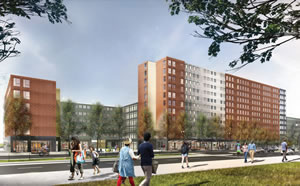Why Your Next Collaboration May Be a P3

PHOTO COURTESY OF EDR
There are two main reasons that Public-Private Partnerships (P3s) are gaining popularity on the higher education campus. The first is that campus administrators desire to focus on their core mission, which is education, and understand that there are organizations that can provide supplemental services better than they provide them. The second is financial: there’s stress on the ability to access sufficient amounts of capital to meet goals and there’s downward pressure on the revenue streams that keep the institutions moving. And make no mistake: P3s are here to stay.
“Administrators are seeing the benefits of successful partnerships,” says Tom Trubiana, president of Memphis-based EdR, a developer, owner and manager of collegiate housing communities. “These benefits include quicker project delivery, not having to staff up to deliver the project, the potential for lower operating costs and preserving their debt capacity for other purposes.” The question is whether you should be considering a P3 to deliver a supplemental service — housing, specifically — to your campus.
Here are two vastly different projects demonstrating the power of P3s. In the first, Detroit-based Wayne State University (WSU) administrators, who have no on-campus housing requirements for students, saw a need and desired to provide more housing on campus for any student needing it. In the second, University of Connecticut (UConn) administrators’ needs were to provide more off-campus housing combined with an urban downtown to attract and retain not only students but also faculty and staff.
Project Goals
WSU: At WSU, a 2010 housing study indicated an excess housing demand, but administrators felt Detroit’s Midtown area could absorb that demand via off-campus housing. When conducted again in 2014, the study showed ongoing and increased demand, plus less availability of off-campus housing. “Midtown housing was becoming more family friendly and less student friendly,” indicates Tim Michael, WSU’s associate vice president for Business and Auxiliary Operations and chief housing officer.
On campus, Michael’s team was turning three-person rooms into four-person rooms, turning lounges into rooms and housing students in hotels. “In four years, the demand doubled from 200 to 400 beds,” he notes. And, with anticipated growth of the student body, as well as seeing an increase of students from farther out in the state, out of state and other countries, demand will continue to grow. “We have 3,050 students on campus now, and we anticipate that to grow to 3,800 by 2020,” he says. “Even at 3,800 beds, we’re still housing just 15 percent or less of our entire student body, so it’s not like we’ll run out of students interested in the opportunity.
“Once we got to the point where both on-campus and community housing couldn’t meet demand, we developed a 10-year master plan to expand our on-campus housing capacity,” Michael continues. The plan, approved in January 2016, included a $250-million investment in new, renovated and removed facilities.
Administrators had five goals in fulfilling the master plan. They wanted numbers off the balance sheet to preserve the university’s capital borrowing capacity, to limit their credit impact, to maintain institutional control and identity, have cash flow to the university and maintain ownership of the assets. “And so we knew we wanted to do some of it with a P3,” Michael sums.

PHOTO COURTESY OF WAYNE STATE UNIVERSITY
UConn: In the early 2000s, UConn administrators conducted a survey of students who chose not to attend the university. “One of the reasons they gave was because there was nothing to do in Storrs,” the village where the school is located, says Tom Callahan, UConn’s associate vice president. Indeed, administrators had a challenge in terms of recruiting not only students, but also faculty and staff, because the community lacked a downtown area. There was no place for commerce, no place for people to gather off campus. As a result, the Downtown Mansfield Partnership, consisting of members from UConn, the Mansfield business community and volunteers from the town of Mansfield and surrounding communities, was formed. The Partnership spent 10 years creating a vision for Storrs Center, a mixed-used area that would include apartments, and it hired Leyland Alliance, Tuxedo Park, NY, to develop it.
Project Financials
WSU: Administrators partnered with East Greenwich, RI-based Corvias to meet their housing master plan goals. “Most P3s are real estate transactions,” says Michael. “We’re using the Concessionaire model, which is a financial transaction in which a Special Purpose Entity (SPE) captures all of the revenues generated. The only claim on repayment of debt is the revenue stream; there’s no lien on buildings or land. The guarantee is the cash flow — the rent paid by the students. It shifts the risk of having to pay debt service and occupancy to the third-party entity.”
Michael and his team anticipate receiving $300 million in June, $100 million of which will pay off the existing debt on the current housing. “Two-thirds of the remainder will pay for demolition and construction of housing,” he explains, “and several million will be used to set up a series of reserves and contingency funds as required by the lending agreements.”
It’s a 40-year partnership, and the agreement allows administrators to renovate the facilities every 10 years. “Our unique approach, which allows all the value and cash flow to stay in the facility partnership,” says Geoff Eisenacher, Corvias’ vice president of Partnership Development, “is self-sustained. It’s comforting to know that the facilities will remain modernized with funds in place, not having to raise new debt or find income, for 40 years.”
UConn: The Downtown Mansfield Partnership was struggling with how to make the numbers work and where to get the financing. Then they brought in EdR, which provided capital. “We helped fulfill their vision by condominiumizing the project, whereby individual units are independently owned and can be sold, to provide more collegiate housing for upper classmen, faculty and staff,” says Trubiana. Today, EdR is the owner and operator of the Oaks on the Square apartment complex, which provides 1,010 beds in 618 apartments with varied floor plans.
Below the apartments are eight buildings with ground floor retail and commercial space totaling 160,000 square feet. Both the apartments and retail space are and have been 100-percent occupied since the first phase opened in 2012.
Here’s how the numbers break down. Total project cost is $204 million, of which $106 million is EdR’s share of the investment, $28 million is the infrastructure funded with public funds and $70 million is Leyland Alliance’s share of investment.
Project Outcomes
WSU: Anthony Wayne Drive On-Campus Apartments will debut in fall 2018 with 407 beds and another 434 beds in fall 2019. The total of 575 units and 841 beds include 258 studio units, 197 one-bedroom units, 47 two-bedroom units and 73 four-bedroom units on a 2.5-acre site with three distinct towers: an 11-story central tower, eight-story North wing and six-story South wing. The 395,000-square-foot development includes 17,000 square feet of retail and a 9,7000-square-foot student health center. “When we open the first phase in August 2018,” says Michael, “it will be the highest-priced housing on our campus, and we believe it will still be 20 percent below market rate.”
UConn: Katie Delaney, community manager of the Oaks on the Square, notes that, “In order to appeal to prospective students and staff, we have to have a product that appeals to everybody.” With a fitness center, business center and yoga studio, the housing is doing just that. The mixed-use retail space is icing on the cake.
Trubiana agrees. “Storrs Center is special because it has transformed the area and the UConn campus. Leyland Alliance, UConn and Mansfield Downtown Partnership worked very, very hard, and without them this project would never have happened. It has been a homerun on every front.”
Is It Your Turn?
These two projects are examples of many housing P3s across the nation, with more to come. In fact, Trubiana notes that, currently, his firm is tracking 31 campus pursuits and has nine under some form of development/construction. Perhaps it’s time for you to begin a conversation with your team about the capability of such a project to add to and/or upgrade your housing stock. If so, he advises administrators to designate and empower a leader who has the ability to make decisions to keep the process moving along at a respectable speed.
“It’s a fact that the number of university officials looking to P3s to solve their housing needs has never been greater, and I’ve been doing this for almost 40 years,” says Trubiana. “They’re seeing the benefits of successful partnerships.” He encourages officials to check references. He also says to remember that you’re picking a partner, not a design, so pick one that has a proven track record and the financial strength to solve problems should something go awry.
Preventing Disputes With Your Partner
One concern that higher education administrators may have when considering a P3 is how to prevent or effectively resolve disputes, especially when entering into a 30-, 40- or 50-year agreement.
Geoff Eisenacher, vice president of Partnership Development for East Greenwich, RIbased Corvias, an organization that partners with higher education and government, explains that his firm creates a three-tiered governance committee with each partner. The committee includes executive, management and operating arms, which review and handle all ongoing issues, items and approvals across all of a project’s levels.
“The governance committee is balanced 50-50,” Eisenacher says. “However, the important part is, because we have a true alignment of interests, are fee-based and working toward the same goal, the concept of dispute resolution is usually around such things as operating expenses and budgets. Because we ensure that the college or university is involved in every single aspect and decision that the partnership is facing, we naturally have fewer disputes.”
This article originally appeared in the issue of .